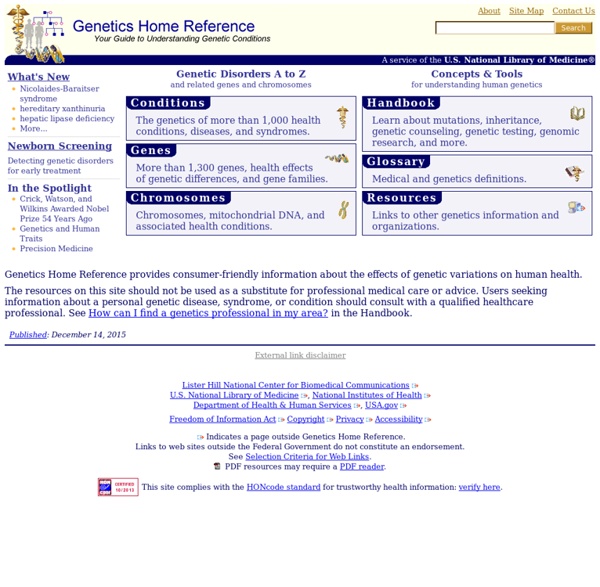



Personal Genetics Education Project 3D Animations - Chromosome 11 Flyover :: DNA Learning Center Home DNA Learning Center Preparing students and families to thrive in the gene age 3-D Animation Library Chromosome 11 Flyover Zoom along a three-dimensional rendering of 650,000 nucleotides of human chromosome 11 to see how little actually encodes protein. Duration: 5 minutes, 54 seconds Transcript: We will now take a tour of about 650,000 nucleotides from the tip of the short arm of human Chromosome 11. (1:25) Next we encounter two small genes that encode olfactory receptors, common features of Chromosome 11. (02:57) The intergenic region is followed by two adjacent ubiquilin genes, which are involved in key cell processes, from replication to "programmed" death. (04:38) Next follows a cluster of four genes in the tripartite motif (TRIM) family. Download Choose a 3-D animation by name: Educational, Media-rich Sites Lab & Bioinformatics Sites Student Summer Camps Products Educator Training Field Trips & Membership © Copyright, Cold Spring Harbor Laboratory.
New Genetic Twist: 4-Stranded DNA Lurks in Human Cells Sixty years after scientists described the chemical code of life — an interweaving double helix called DNA — researchers have found four-stranded DNA is also lurking in human cells. The odd structures are called G-quadruplexes because they form in regions of deoxyribonucleic acid (DNA) that are full of guanine, one of the DNA molecule's four building blocks, with the others being adenine, cytosine, thymine. The structure comprises four guanines held together by a type of hydrogen bonding to form a sort of squarelike shape. The new visualization of the G-quadruplex is detailed this week in the journal Nature Chemistry. "I think this paper is important in showing directly the existence of this structure in vivo in the human genome, but it is not completely unexpected," said Hans-Joachim Lipps, of the University of Witten in Germany, who was not involved in the study. But scientists still didn't have concrete evidence for its existence in the human genome.
Chromosome Abnormalities Fact Sheet Chromosome Abnormalities What are chromosomes? Chromosomes are the structures that hold genes. Genes are the individual instructions that tell our bodies how to develop and function; they govern physical and medical characteristics, such as hair color, blood type and susceptibility to disease. Many chromosomes have two segments, called "arms," separated by a pinched region known as the centromere. Top of page Where are chromosomes found in the body? The body is made up of individual units called cells. How many chromosomes do humans have? The typical number of chromosomes in a human cell is 46: 23 pairs, holding an estimated total of 20,000 to 25,000 genes. Of the 23 pairs of chromosomes, the first 22 pairs are called "autosomes." How do scientists study chromosomes? For a century, scientists studied chromosomes by looking at them under a microscope. To help identify chromosomes, the pairs have been numbered from 1 to 22, with the 23rd pair labeled "X" and "Y." Glossary of Terms
Cracking the Code of Life Cracking the Code of Life PBS Airdate: April 17, 2001 ROBERT KRULWICH: When I look at this—and these are the three billion chemical letters, instructions for a human being—my eyes glaze over. But when scientist Eric Lander looks at this he sees stories. ERIC LANDER (Whitehead Institute/MIT): The genome is a storybook that's been edited for a couple billion years. ROBERT KRULWICH: This is the story of one of the greatest scientific adventures ever, and at the heart of it is a small, very powerful molecule, DNA. For the past ten years, scientists all over the world have been painstakingly trying to read the tiny instructions buried inside our DNA. J. FRANCIS COLLINS (National Human Genome Research Institute): This is the ultimate imaginable thing that one could do scientifically...is to go and look at our own instruction book and then try to figure out what it's telling us. ROBERT KRULWICH: And what it's telling us is so surprising and so strange and so unexpected. I'm Robert Krulwich. DR.
Teach.Genetics™ The Fruit Fly and Genetics Personals: ♀ FF, Se/E/Dp, seeks ♂ FF, +/+/+ for short term relationship. Enjoys romance, fermentation, and long walks on the peach... You know those annoying little bugs that like to get in your fruit if you leave it on the counter? Well they're called Drosophila melanogaster (or just fruit flies) and they've been used to study genetics for over 100 years. This interactive website is designed to introduce biology students to research on model organisms while reviewing genetics basics. Learning about Genetics Using Flies Model organisms are species that are studied to understand the biology of other organisms, often humans. Fruit flies in vials with media. Low Maintenance Creatures Fruit flies are great to work with in a research setting because they are relatively easy to take care of, especially compared to larger and more expensive organisms like rats or fish. Knocking Them Out The fruit flies do fly, of course, so they have to be knocked out before they come out of their vials.
How to work with Drosophila The Natural Science for Teachers Program (formerly General Biology Program for Teachers) offers graduate-level online courses and enrichment opportunities for teachers. The program was designed to address the needs of middle and high school science teachers for graduate-level courses that meet many school districts’ requirements for salary increment credit. Currently we offer 2 educational tracks: Biology and Chemistry. Teachers may participate two ways: 1) Through our non-degree program, teachers may update their content knowledge without having to earn a M.S degree, or through the 2) M.S. in Natural Science for Teachers: This innovative Masters Degree Program takes place online primarily over the summers, so that teachers need to complete only minimal course work while they are teaching. More than 60 teachers earned the M.S. in General Biology degree from inception in 1993 to 2010 when the program changed to Natural Science for Teachers.
Forensic Science Simplified